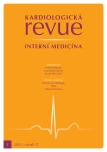Catheter ablation of atrial fibrillation
Authors:
V. Durdil
Authors‘ workplace:
Kardiologická klinika 2. LF UK a FN v Motole, Praha
Published in:
Kardiol Rev Int Med 2015, 17(1): 28-31
Category:
Cardiology Review
Overview
Catheter ablation of atrial fibrillation is currently the most effective specific antiarrhythmic therapy. The technique of the procedure is steadily developing and its safety and efficacy is growing. The article presents an overview of the basic aspects of catheterization treatment, including the indications, pathophysiology, new technologies and techniques of catheter ablation of atrial fibrillation.
Keywords:
atrial fibrillation – catheter – ablation – history – pathophysiology – technique – complications – indications
Sources
1. Haissaguerre M, Jais P, Shah DC et al. Spontaneous initiation of atrial fibrillation by ectopic beats originating in the pulmonary veins. N Engl J Med 1998; 339: 659– 666. doi: 10.1056/ NEJM1998.09033391003.
2. Pappone C, Rosanio S, Oreto G et al. Circumferential radiofrequency ablation of pulmonary vein ostia: A new anatomic approach for curing atrial fibrillation. Circulation 2000; 102: 2619– 2628. doi: 10.1161/ 01.CIR.102.21.2619.
3. Shah RU, Freeman JV, Silane D et al. Procedural complications, rehospitalizations, and repeat procedures after catheter ablation for atrial fibrillation. J Am Coll Cardiol 2012; 59: 143– 149. doi:10.1016/ j.jacc.2011.08.068.
4. Cappato R, Calkins H, Chen SA et al. Updated worldwide survey on the methods, efficacy, and safety of catheter ablation for human atrial fibrillation. Circ Arrhythm Electrophysiol 2010; 3: 32– 38. doi: 10.1161/ CIRCEP.109.859116.
5. Camm AJ, Lip GY, De Caterina R et al. 2012 focused update od the ESC Guidelines for the management of atrial fibrillation. Eur Heart J 2012; 33: 2719– 2747. doi: 10.1093/ eurheartj/ ehs253.
Labels
Paediatric cardiology Internal medicine Cardiac surgery CardiologyArticle was published in
Cardiology Review

2015 Issue 1
Most read in this issue
- TDM of digoxin in clinical practice
- Drug interaction and current clinical practice
- Cardiac resynchronization therapy – when should it be indicated and for whom?
- TDM of antibiotics in clinical practice
